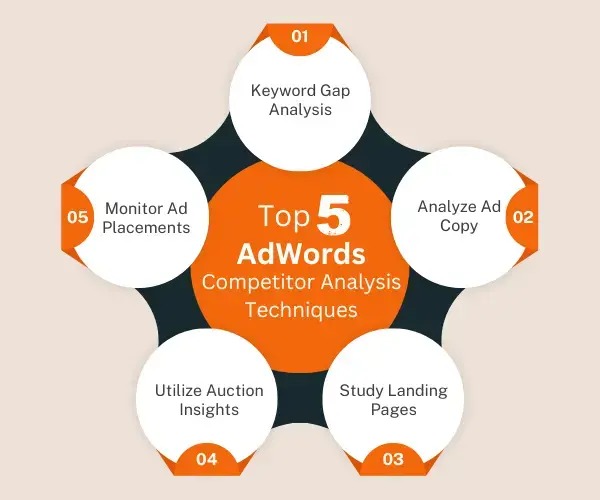If you want to make progress in your advertising campaigns, then you must know what your competitors are doing. As new enterprises expand and attract customers seeking the same products or services, it is crucial to review rivals’ AdWords and PPC tactics. You can stay ahead in the market by implementing effective AdWords and PPC competitor analysis techniques in your campaigns. In this blog, you will get to know about the top techniques that can give you an edge over your competition.
What is the Difference Between AdWords and PPC?
AdWords, now known as Google Ads, is a specific platform where businesses bid for keywords to place their advertisements on Google search as well as other websites within the Google network. On the other hand, PPC stands for pay-per-click and covers all online advertising models where advertisers pay a fee each time their ads are clicked. Note that AdWords is a type of PPC advertising; however, PPC also encompasses other platforms like Bing Ads, Facebook Ads, etc.
Top 5 AdWords Competitor Analysis Techniques
1. Keyword Gap Analysis
Nothing is more efficient than a keyword gap analysis in revealing your competitors’ strategies. This concerns utilizing the available tools to find out the keywords your competitors are targeting that you are not. Using the focus keywords, developing content and advertising strategies can be possible to help capture the lost traffic. Furthermore, keyword gap analysis helps to find out what keywords you missed and did not include in your content.
2. Analyze Ad Copy
Exploring what your competitors have placed into their advertisements can be helpful. See what catchy terms they used in their headlines, keywords, and the calls to action included in their adverts. Find out what makes their ad copy great and think about how you could use some of their approach on your brand. Observe what shifts their audience’s emotions and how they relate to their audience’s problems or needs. An insight into these aspects enables one to come up with a better Ad copy that would appeal to your niche market and gain high activity rates.
3. Monitor Ad Placements
The analysis of ad placement informs you about competitors’ targeting and their preferred types of ads. For example, are they investing more in search ads, display ads, or video ads? This knowledge empowers you to alter your strategies and select the ones that are more favorable in terms of placement among your targeted audience. Furthermore, effective monitoring of ad placements helps you identify future opportunities where your audience may be engaging, thus providing more exposure and enhancing your brand’s presence.
4. Study Landing Pages
Among other sources, your competitors’ landing pages can prove valuable. By reading the page layouts of competitors’ landing pages and questioning their content and calls to action, you can determine which aspects to use on your landing pages. Specifically, think about the components of their webpage that are engaging for the target audience and centered on conversion goals. Also, consider things like general user experience, loading times, and the site’s responsiveness to mobile devices.
5. Utilize Auction Insights
Features such as Auction insights within Google Ads offer statistical data that will show the position of your ads with others. With this tool, you can see who you are competing with in terms of ad space and then align your actions according to what your rivals are doing. Looking at auction analyses regularly allows you to track changes in the competitive environment and adapt to them. Utilize this data for making necessary changes in your bids, targeting, and ad placements to get the best results from your advertising campaigns.
Top 5 PPC Competitor Analysis Techniques
1. Use PPC Intelligence Tools
There are special PPC intelligence techniques & tools available that can assist you in growing your business by monitoring the activities of your competitors. These tools gather information on the spending budgets of advertising competitors, keywords used, and overall advertising campaign results. Using this information, you can more easily find strategies to fine-tune your advertising campaigns.
2. Review Competitor Ads Across Multiple Platforms
PPC is not bound to Google alone and there are other platforms to use as well. Analyze advertisements on various platforms such as Facebook, Instagram, and even Bing. This decision can help expand your perspective on competitors’ movements and might uncover new prospects that have not been previously seen. For example, you can find out that the competitor uses some ad format that is highly efficient in your industry or targets a specific niche that you did not pay attention to before. That way, it’s possible to find new possibilities for improvement and have a broader perspective altogether.
3. Track Ad Frequency and Timing
Understanding how often and when your competitors’ ads appear can offer valuable clues about their budget and targeting strategies. Use tools like ad spy software or manual checks to monitor ad frequency and timing. This information can help you optimize your ad schedules for better reach and engagement. For example, if you notice a competitor running ads frequently during certain hours or days, you might want to schedule your ads similarly to capture the same audience.
4. Analyze Audience Targeting
Analyzing competitors’ audiences allows you to reveal segments and demographics that you might not have considered. There are tools such as audience insights and social media analytics that one can use to capture data concerning their followers. This may help you to target your advertising campaigns to those potential buyers more efficiently. For example, if you find out that your rival is focused on an audience aged between 20-30 and only on Instagram, then you may change ad visuals and slogans to meet this audience’s needs.
5. Assess Bidding Strategies
The auction strategies of your competitors in the business affect your strategies and plans. Notice which model they use, cost-per-click (CPC), cost-per-thousand-impressions (CPM), or other similar ones. Evaluate the ads’ positioning and the competition for certain keywords and target markets. It can help you determine the best bidding model for your campaigns to get the best value for your money. For instance, if you see that the competitor is always placing a high bid for a specific keyword, then you might decide to target the variant keywords that attract equal traffic at a lesser price.
Conclusion
Performing PPC & adWords competitor analysis is a continuous process that can drive significant growth in your marketing strategies. You can monitor your competitors’ tactics and refine your approach to get the best results. Do remember that this is not a one-time activity, you have to perform these activities from time to time to give your business the competitive edge it deserves.
Read More From Techbullion And Businesnewswire.com





































